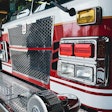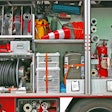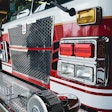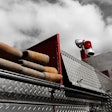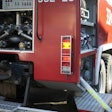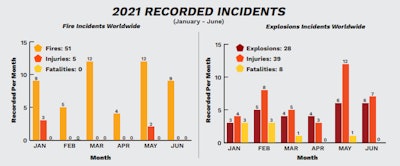
Since 2016, Dust Safety Science has published semi-annual reports analyzing the materials, industries and equipment involved in combustible dust fires and explosions around the world.
Below is a summary of the dust fires and explosions uploaded into the combustible dust incident database in 2021.
These incidents are captured in its incident report. Subscribe to receive a free PDF copy of the 50-page document here.
2021 global loss overview
In the first half of 2021, all of the fatalities recorded occurred due to dust explosions. Of the injuries, 89% occurred due to explosions and 11% occurred due to fires.
Some of the more severe incidents include:
One killed in seed cleaning dust explosion (Silverton, OR)
Three injured in grain elevator fire (Brooks, Alberta)
Three killed in power plant explosion (Angren, Uzbekistan)
Several killed in potato starch explosion (Tuas, Singapore)
Limited information has been available for damages from dust explosions and fires. From the information that is available, only two incidents resulted in more than $1,000,000 in losses so far:
Fatal explosion causes $1.4M in damages (Sliverton, OR)
Animal feed fire causes $2M in damages (North Java, NY)
Materials involved
In reviewing the global incident data, food and wood products made up over 75% of the combustible dust fires and explosions recorded.
These materials also resulted in 61% of the injuries and 62% of the fatalities. A breakdown of the fires, explosions, injuries and fatalities for each type of material is given as follows:
The four injuries from metal dust involved an explosion at a zinc powder facility. The three fatalities and three injuries from coal dust were involved in an explosion at a thermal power plant. The other two injuries from coal dust involved an explosion at a carbon production facility.
Under the category “other”, two injuries came from separate explosions involving rubber dust. Four workers were injured in an unspecified chemical dust explosion at a pharmaceutical plant. One worker was also injured in a sulphur dust explosion at a tire manufacturing plant
Industries involved
As shown in the historical data, wood processing, wood products, agricultural activity and food production make up a large portion of the overall fire and explosion incidents. Since 2017, wood products have ranged from 21% to 28% of the incidents, while agricultural activity and food production has ranged from 33% to 50%.
As shown in the detailed incident breakdown, the “other” category includes pulp & paper, ethanol, high schools, and educational facilities. Industries not broken out in the detailed breakdown include rubber products, lawn products, graphite and carbon products, food packaging, pharmaceutical, residential, plastics and waste treatment.
Combined, the overall “other” category of industries makes up 45% of the injuries and 37% of the fatalities reported in the first half of 2021. Wood and wood products, agriculture and food processing, and automotive and metalworking make up 20%, 25% and 2.3% of the injuries, respectively. Fatalities were recorded in wood and wood products, agricultural, power generation and fire protection system manufacturing industries.
Equipment and causes
In the first half of 2021, storage silos demonstrated the highest percentage of combustible dust incidents with six fires and six explosions reported. This is a higher percentage than the 2017 and 2018 reports which found that dust collection systems had the highest percentage of incidents occur. So far in 2021, only 13% of the fires and explosions occurred in dust collection systems.
Dryers had the largest number of injuries in the first half of 2021 with four injuries in a pharmaceutical dryer explosion, one injury in a grain dryer explosion and one injury in a wood pulp and flower dryer explosion. Three storage silo and bin explosions resulted in three more injuries.
The breakdown between fires, explosions, injuries and fatalities for different pieces of equipment are summarized in the following table for 2021:
Equipment labelled under “Other” had 23% of the total incidents, 20% of the injuries and 37% of the fatalities. These incidents include an explosion involving a potato starch mixer that killed three and injured seven, and an explosion in a coal handling system that injured two.
Incidents for which no details were provided for the equipment made up 19% of the total reported. However, these incidents made up 45% of the reported injuries and 62% of the reported fatalities.
These incidents are captured in its incident report. Subscribe to receive a free PDF copy of the 50-page document here.








